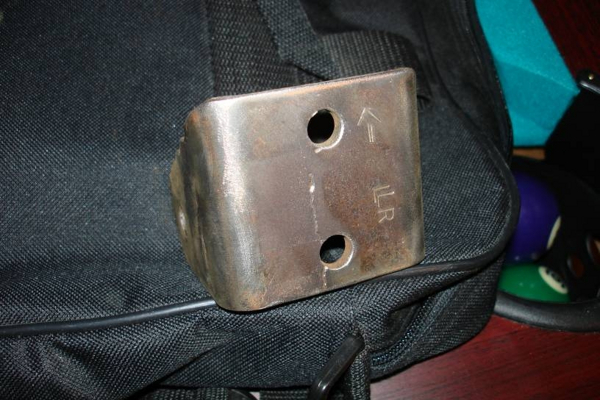MG-Cars.com
Triumph TR6 Trailing Arm Bracket - Crack BBS discussion at MG-Cars.net

MG-Cars.net
Welcome to our resource for MG Car Information.
Recommendations
Parts
TR parts and Triumph parts, TR bits, Triumph Car Spares and accessories are available for TR2, TR3, TR3A, TR4, TR4A, TR5, TR6, TR7, TR8, Spitfire and Stag and other TR models are available from British car spares and parts company LBCarCo.
Triumph TR6 - Trailing Arm Bracket - Crack
| In the interests of the safety of TR IRS drivers I thought I'd share this one. I have my trailing arms out for bushing replacement and was doing a general cleanup and repaint of the TA's, shocks and springs before the reinstall. I was going to skip cleaning and painting the trailing arm brackets because they are not visible but they were so grungy I thought, "why not" in the interests of having nice, clean stuff to work with. The left inner, 3-notch bracket was cracked from the bottom of the bracket, through the bottom bolt hole up to the top bolt hole and the crack was right through, front to back. I did not want to weld it so I ordered a new one last night to arrive with my new Robbins top in a week or two. While it "may not" have caused a catastrophic failure at city speeds it could have gotten interesting if it broke in half on the highway. I would not have noticed this if I had not decided to clean and paint the brackets and all the accumulated grunge completely covered up the damage until I hit it with the wire wheel on my drill. If you rebush your TA's, please inspect the brackets. Attached pic is the best I could get. It is worse than it looks here. Bob  |
| Bob Evans |
| Bob- You do know that the brackets are paired and there are different pieces sold as the years went on? |
| DON KELLY |
| Don - yes, I've done some reading on the brackets and understand that there are 1, 2 and 3-notch types covering various years/commission numbers. My '76 has what appears to be correct, with 3-notch inners and 1-notch outers. My car had three shims in each position except one on the left which had four. Bob |
| Bob Evans |
| Just out of curiosity at either end of the cracks are you seeing burrs or nicks? What about that little shiny spot at about the 11 o'clock position on the upper hole, any sign of the crack breaking out there or anywhere else on that hole? |
| SteveP1 |
| Good eye Steve. The 11 o'clock shiny bit is a small burr, as if the bolt was exerting upward pressure on an angle but the crack radiates left of that, away from the hole. On the inside (other side) it is a hairline crack and it has reached to within 1/4" of the top. On the photo shown above it is not up that far but it is wider and deeper. That is a big nick at 7 o'clock low between the two holes. In any case it's garbage and the new one is on the way. I posted over on British Car Forum and a number of guys had the problem and some posted nasty pics. One guy has cracks in two brackets. Definitely my week for finding stuff. The retaining bolt in the clutch fork in my spare gearbox was cracked off. The PO just screwed the "half bolt" back in, no retaining wire. There was just enough bolt to grab the shaft. Bob |
| Bob Evans |
| I used to get to look at lots of failed parts and long ago decided barring a rogue flaw in the material or grevious machining error, just about the worst thing you can do to something from fatigue standpoint is put a hole in it. But then again, we need holes to attach things. This is why I have made a point of taking new hires out and showing them all of the "impressive bits" and then take them to an area where holes are being hand drilled. I then explain to them that the single most important thing we do is put holes in stuff. This is followed by a brief talk on the types of things that can go wrong making holes and how they adversely impact fatigue life. |
| SteveP1 |
| Steve-Any idea why the TA brackets crack in this particular location? I am also a member of the cracked bracket club. Berry |
| BTP Price |
| Sorry for the delay, between a holiday, an anniversary and a funeral, it's been a bit busy the last week. I think a big part of it is that the brackets are not really a "precision" part. By that, I mean that they are formed up from thick sheet/thin plate material and are made with clearance fit holes for the bolts that are not well cleaned up after the they are made. These are commodity parts and with holeseither punched or drilled quickly and with them being formed and holes made quickly, there isn't the kind of time available to make really nice holes. Nicks and burrs from the hole making process act as stress concentration points and they in turn are more easily overloaded at a very localized level and then serve as a crack initiation point. You can essentially think of them as a "pre-crack." The crack will propogate through the part, typically toward the next hole or nearest edge. As it grows, the stress concentration at the crack tip increases and the speed of the crack growth increases right along with it. When it gets to the next hole, the stress concentration is reduced but will enventually find a weak point and propogate out of that hole and move on down the line until there is no where for it to go. The other thing going on is the fit of the fastener, clearance fits do OK as long as the loads are tensile in nature, but in this case you have tensile and a shear component in the loading. Clearance holes are not good when it comes to transferring shear loads, but interference fit fasteners for this application would have made manufacturing a pain somewhat removed from the neck if you know what I mean (and I bet you do). Bottom line out of all this, when you drill, make the best hole possible and deburr it. If you buy a part, look at the holes before installation and deburr as necessary. Deburr it using either small flat files, scotch brite pads (either hand if light enough or a pad on small angled die grinder) or a very light hit with a proper counter sink tool (often by hand not even chucked into a tool). If you grab one of those "hook type" deburrers and use it in a hole, odds are you will have just gouged hell out of it. Those are intended for rough edge breaking, not real deburring. Personally, I don't even like the thought using them for that very much, they are not allowed in my tool box. |
| SteveP1 |
| Steve-Thanks for the reply&explanation. It makes sense as I couldn't see where the stress load in that area could produce a crack. I ground a v in the crack and welded it about 10 years ago and definitely will check it. I wonder if the GP brackets will start to show the same crack. Berry |
| BTP Price |
| Berry, Given enough time and number of cycles even Richard's brackets will eventually go tango uniform, but given the use these cars typically see today there's a reasonably good chance that they will outlive us. His are a thcker material which helps, but as much as I really like Richard's stuff, I typically don't care for the supplied hardware and replace it with bits from my stash of stuff. As an example, on the brackets, Richard supplies them with Grade 8 hardware and with that you don't get the same level of gradients for the grip lengths (1/4") that you do with genuine TR hardware (1/8") or AN stuff (1/16"). The bolts supplied do not completely take the grip all the way out to the end of the hole bores which does two things that are bad in my mind. First is that it puts threads in shear and threads are the weakest part of the fastener. The other thing is that those threads can grind and fret away with themselves and the bracket so both the fastener and the structure get chewed up over time. It's AN7-41 (IIRC) and AN6-some long grip length number that I can't remember to the rescue. No threads in shear, no grinding/fretting of threads and structure. This is not a slam aimed at Richard, I've talked with him on occassion and he's a very nice guy. Overall, his stuff is first rate, it's the supplied hardware that I think could be better. I've gotten stuff from Revington TR to provide another mini case study (that was some reasonably large bucks/quid) and the hardware in that was possibly the worst I've ever seen even though the actual items of interest were very good. It's just the nature of things, I'm particular about the hardware and most of the stuff that people supply with their parts leaves something to be desired to me. I guess it's all that time looking at broken stuff and determining the cause that drives it. Or perhaps it's a case of life imitates an old Darryl Rhoades song's refrain "cause I'm anaaaaaal, anal retentive." |
| SteveP1 |
hmmm...Tangle Uniform
 |
| DON KELLY |
This thread was discussed between 29/06/2011 and 11/07/2011
Triumph TR6 index